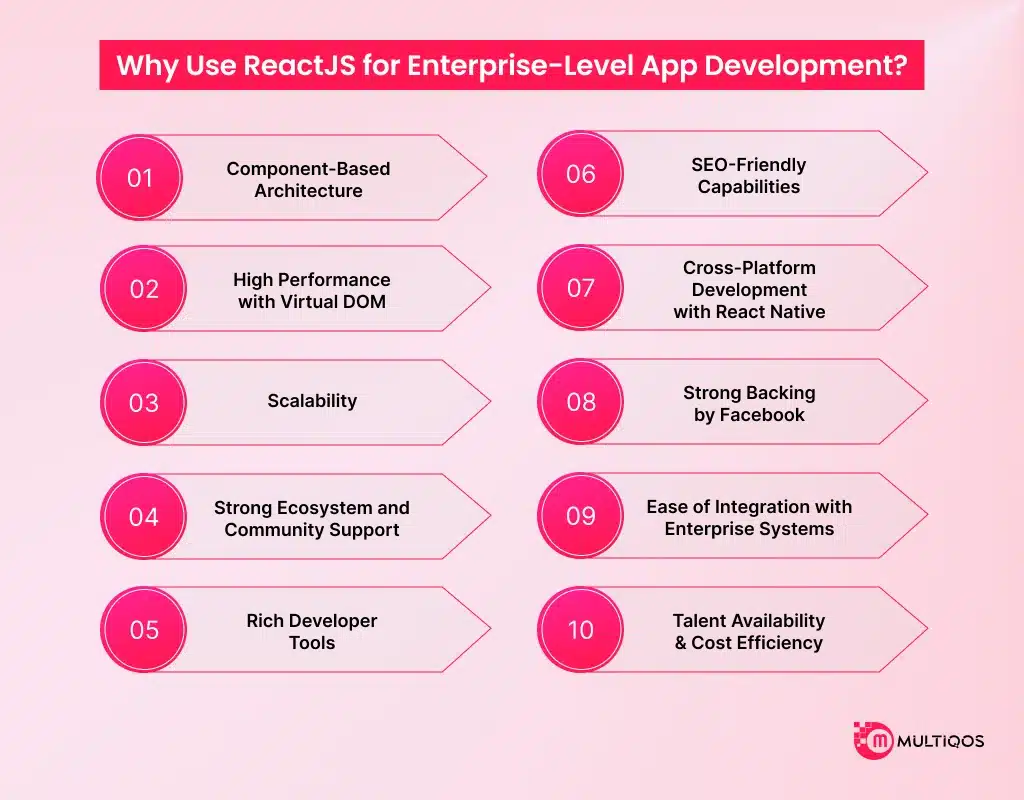Why ReactJS is Ideal for Enterprise-Level App Development?

Summary:
ReactJS has emerged as a powerful front-end library that is particularly well-suited for enterprise-level app development. Its component-based architecture, virtual DOM, and reusable UI elements enable faster development cycles, improved scalability, and easier maintenance—key priorities for large-scale enterprise applications.
Backed by Facebook and a massive community, ReactJS offers long-term support, robust tooling, and a rich ecosystem of libraries and integrations that streamline enterprise workflows. Overall, ReactJS for enterprise-level app development delivers the performance, flexibility, and reliability required to meet the demands of modern businesses.
Introduction
From sophisticated mobile applications to simple websites, a business needs strong and scalable applications to stay competitive. The front-end technology selection aids in this goal through its offerings, and that is exactly where ReactJS for enterprise-level app development shines.
Since its inception by Facebook, and with the constant support of its enormous developer community, ReactJS has always been the answer for building modern, reliable, responsive, and easy-to-maintain applications of any scale.
From internal business tools to customer-facing platforms as well as mission-critical systems, large organizations have numerous use cases that ReactJS serves with unparalleled flexibility, performance, and dependability. In this blog, we’ll list out the best reasons to choose React.js for app development, which enables teams to deliver an unmatched digital experience.
Why Use ReactJS for Enterprise-Level App Development?
Are you wondering why so many businesses go with React? These 10 compelling reasons demonstrate why ReactJS for Enterprise-level app development is a great choice for creating scalable, high-performing applications.
1. Component-Based Architecture
Due to ReactJS’s component-based architecture, user interface elements are divided into discrete, reusable components. Such granularity enables enterprise groups to achieve uniformity in large codebases and simultaneously speed up development. Different projects have distinct deadlines, so it is easier to update and reuse components, which allows faster development and smoother collaboration among developers.
2. High Performance with Virtual DOM
Through the elimination of communication with the real DOM, React’s virtual DOM improves application performance. Businesses and developers choose ReactJS when developing complex and large-scale enterprise applications due to its component-based architecture, scalability, and superior performance. Better user experiences and quicker responsiveness are vital for business efficiency in enterprise-level applications that handle massive volumes of real-time data and user interactions.
3. Scalability
ReactJS development handles projects of all magnitudes due to its flexible architecture. Its enterprise applications can scale vertically and horizontally (growing the number of users). Even state management and code scaling are simplified with Redux, Context API, and TypeScript support—especially for distributed teams.
4. Strong Ecosystem and Community Support
React is backed by a vibrant communities of developers. To enterprises, this opens up a world of perpetual innovation, tutorials, community-tested solutions, and countless third-party libraries. Ranging from routing (React Router), form handling (Formik), and most importantly, state management (Redux, Zustand), the tools that React’s ecosystem provides enhance development speed and improve functionality.
5. Rich Developer Tools
Features like monitoring and debugging become easy for developers due to React Developer Tools and other similar extensions, which help them view component order and also track performance. For advanced-level development, especially in cases with intricate user interface designs, these tools are a requirement because being able to see component states and props minimizes the time spent in debugging and increases the quality of code written.
6. SEO-Friendly Capabilities
ReactJS app development offers features like server-side rendering (SSR), static site generation (SSG), and metadata configuration that can enhance app search engine optimization (SEO) when combined with Next.js or Gatsby. Businesses with customer-focused platforms or marketing websites that rely on search engines for user traffic and potential customers will find this helpful.
7. Cross-Platform Development with React Native
Giant businesses can use React Native to create iOS and Android mobile apps by utilizing the same concepts and elements as ReactJS. While guaranteeing consistent brand experiences across platforms, this unified development approach drastically cuts down on time-to-market and resource requirements.
8. Strong Backing by Facebook
Meta (formerly Facebook) also uses ReactJS development due to its stability, regular updates, and continuous support are guaranteed. When making long-term investments in technology stacks, enterprise stakeholders can rest easy knowing that React is dependable and durable because of this support.
9. Ease of Integration with Enterprise Systems
Microservices, REST and GraphQL APIs, and legacy systems—all of which are frequently encountered and are easily integrated with ReactJS. Due to its adaptability, teams can quickly update current infrastructure and integrate different backend technologies (such as Python, Java, or .NET) without having to start from scratch.
10. Talent Availability & Cost Efficiency
Because ReactJS is so popular, there is a huge global pool of talented developers. Employing ReactJS developers who can get started quickly is now simpler and less expensive for businesses. Furthermore, internal teams can quickly upskill and maintain applications internally thanks to React’s moderate learning curve.
Top 7 Companies Using ReactJS Development
These top 7 businesses use ReactJS to create enterprise-level apps that provide quick, scalable, and dynamic user experiences. These companies demonstrate how React powers everything from high-performance customer interfaces to real-time collaboration.
1. Meta (Facebook)
Meta (formerly Facebook), the company that created ReactJS, makes extensive use of it in its own products. React was used in the development of the Facebook web app to give its billions of users a very dynamic and real-time experience. Facebook’s feed updates, notifications, and smooth navigation depend on React’s effective rendering through the virtual document object model.
2. Instagram
Instagram, which is also owned by Meta, is among the best examples of a single-page application that uses ReactJS. Even during times of high traffic, React manages features like real-time messaging, tagging, live updates, and embedded media, enabling smooth user interactions and fast loading times.
3. Netflix
ReactJS was used by Netflix to improve front-end platform performance, especially on low-performance devices like smart TVs. Their platform’s rendering layer, React, ensures a quick and responsive user interface that efficiently manages playback, recommendations, and content browsing.
4. Airbnb
React is used by Airbnb to create its user dashboards and highly interactive booking platform. React’s reusable components allow for consistent behavior and design across site sections, which facilitates scaling and maintenance as new features are added.
5. Uber
Dashboards, real-time maps, and business intelligence tools are just a few of the internal and external applications that Uber uses ReactJS for. React is perfect for Uber’s high-demand environment because it can quickly render complex interfaces and large data sets.
6. Dropbox
Dropbox uses ReactJS to make file sharing and cloud storage seamless. Drag-and-drop interfaces, interactive document previews, and real-time collaboration are just a few of the advanced features that React powers while ensuring peak performance.
7. WhatsApp Web
You’ll be surprised to know that WhatsApp Web is also built using ReactJS development, basically for its desktop version. Because of React’s effective UI management and real-time rendering capabilities, users can communicate, access media, and send messages with little lag.
Wrapping Up
Using ReactJS for enterprise-level app development has been a wise choice for creating scalable, effective, and future-ready applications. Its component-based architecture, robust ecosystem, and framework integration capabilities make it perfect for complex business requirements. ReactJS gives businesses an advantage in fierce competition by improving user experience delivery and the development process.
The effectiveness of enterprise-level applications depends on the proper team structure. If you want to create a robust and feature-rich enterprise application, you need the right team. So, it is suggested to hire ReactJS developers with the know-how to make the most of this cutting-edge framework and achieve your business goals.
FAQs
Indeed, ReactJS adheres to strict security guidelines and can support safe, legal enterprise apps when paired with secure development methods.
Of course. Large codebases, real-time data handling, and integration with enterprise-level backends and APIs are all supported by React’s ecosystem and flexibility.
React’s virtual DOM, reusable components, and extensive library support enable development teams to work more quickly and effectively, which shortens time-to-market.
Get In Touch








